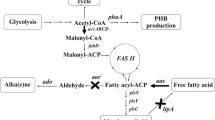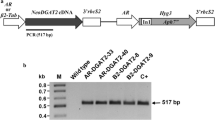Abstract
Cyanobacteria have immense prospective as a platform for renewable energy; however, a major barrier in achieving optimal productivity is the low lipid yield. Fremyella diplosiphon, a model cyanobacterium, is an ideal biofuel agent due to its desirable fatty acid methyl esters (FAMEs). To enhance lipid content, we overexpressed the sterol desaturase (SD) gene in F. diplosiphon B481 wild type by genetic transformation. This effort resulted in a transformant (B481-SD) with a 64-fold increase in the SD gene at the mRNA transcript level, with no loss in growth and pigmentation. The transformant was persistently grown for over 32 generations indicating long-term stability and vitality. We observed 27.3% and 23% increases in total lipid content and unsaturated FAMEs respectively in B481-SD transesterified lipids with methyl octadecadienoate as the most abundant unsaturated component. In addition, we detected an 81% increase in FAME composition in the transformant compared with the wild type. Theoretical physical and chemical properties confirmed a FAME profile with very high cetane number (65.972–67.494) and oxidative stability (50.493–18.66 h) in the engineered strain. Results of the study offer a promising approach to augment F. diplosiphon total lipid content and unsaturated FAMEs, thus paving the way to enhance biofuel capacity of the organism.









Similar content being viewed by others
References
Nozzi, N. E., Oliver, J. W., & Atsumi, S. (2013). Cyanobacteria as a platform for biofuel production. Frontiers in Bioengineering and Biotechnology, 1, 7–13.
Los, D. A., & Mironov, K. S. (2015). Modes of fatty acid desaturation in cyanobacteria: an update. Life, 5(1), 554–567.
Murata, N., Wada, H., & Gombos, Z. (1992). Modes of fatty-acid desaturation in cyanobacteria. Plant and Cell Physiology, 33(7), 933–941.
Sharathchandra, K., & Rajashekhar, M. (2011). Total lipid and fatty acid composition in some freshwater cyanobacteria. Journal of Algal Biomass Utilization, 2(2), 83–97.
Sato, N., & Awai, K. (2016). Diversity in biosynthetic pathways of galactolipids in the light of endosymbiotic origin of chloroplasts. Frontiers in Plant Science, 7, 117–123.
Murata, N., & Wada, H. (1995). Acyl-lipid desaturases and their importance in the tolerance and acclimatization to cold of cyanobacteria. Biochemical Journal, 308(1), 1–8.
Kamthan, A., Kamthan, M., & Datta, A. (2017). Expression of C-5 sterol desaturase from an edible mushroom in fission yeast enhances its ethanol and thermotolerance. PLoS One, 12(3), e0173381.
Kramm, A., Kisiela, M., Schulz, R., & Maser, E. (2012). Short-chain dehydrogenases/reductases in cyanobacteria. The Federation of European Biochemical Societies Journal, 279(6), 1030–1043.
Nguyen, M. A., & Hoang, A. L. (2016). A review on microalgae and cyanobacteria in biofuel production. Economies and F inances, 1–37.
Tabatabai, B., Chen, H., Lu, J., Giwa-Otusajo, J., McKenna, A. M., Shrivastava, A. K., & Sitther, V. (2018). Fremyella diplosiphon as a biodiesel agent: identification of fatty acid methyl esters via microwave-assisted direct in situ transesterification. Bioenergy Research, 11(3), 1–10.
Tabatabai, B., Arumanayagam, A. S., Enitan, O., Mani, A., Natarajan, S. S., & Sitther, V. (2017). Overexpression of hlyB and mdh genes confers halotolerance in Fremyella diplosiphon, a freshwater cyanobacterium. Enzyme and Microbial Technology, 103, 12–17.
Tabatabai, B., Gharaie Fathabad, S., Bonyi, E., Ra**i, S., Aslan, K., & Sitther, V. (2019). Nanoparticle-mediated impact on growth and fatty acid methyl ester composition in the cyanobacterium, Fremyella diplosiphon. Bioenergy Research In press.
Singh, S. P., & Montgomery, B. L. (2013). Salinity impacts photosynthetic pigmentation and cellular morphology changes by distinct mechanisms in Fremyella diplosiphon. Biochemical and Biophysical Research Communications, 433(1), 84–89.
Kehoe, D. M., & Grossman, A. R. (1998). Use of molecular genetics to investigate complementary chromatic adaptation: advances in transformation and complementation. Methods in Enzymology, 297, 279–290.
Kahn, K., Mazel, D., Houmard, J., De Marsac, N. T., & Schaefer, M. R. (1997). A role for cpeYZ in cyanobacterial phycoerythrin biosynthesis. Journal of Bacteriology, 179(4), 998–1006.
De Marsac, N. T., & Houmard, J. (1988). Complementary chromatic adaptation: physiological conditions and action spectra. Methods in Enzymology, 167, 318–328.
Whitaker, M. J., Bordowitz, J. R., & Montgomery, B. L. (2009). CpcF-dependent regulation of pigmentation and development in Fremyella diplosiphon. Biochemical and Biophysical Research Communications, 389(4), 602–606.
Folch, J., Lees, M., & Sloane Stanley, G. H. (1957). A simple method for the isolation and purification of total lipids from animal tissues. Journal of Biological Chemistry, 226(1), 497–509.
Wahlen, B. D., Willis, R. M., & Seefeldt, L. C. (2011). Biodiesel production by simultaneous extraction and conversion of total lipids from microalgae, cyanobacteria, and wild mixed-cultures. Bioresource Technology, 102(3), 2724–2730.
Rosenberg, J. N., Kobayashi, N., Barnes, A., Noel, E. A., Betenbaugh, M. J., & Oyler, G. A. (2014). Comparative analyses of three Chlorella species in response to light and sugar reveal distinctive lipid accumulation patterns in the microalga C. sorokiniana. PLoS One, 9(4), e92460.
Talebi, A. F., Tabatabaei, M., & Chisti, Y. (2014). BiodieselAnalyzer: a user-friendly software for predicting the properties of prospective biodiesel. Biofuel Research Journal, 1(2), 55–57.
Ramos, M. J., Fernandez, C. M., Casas, A., Rodriguez, L., & Perez, A. (2009). Influence of fatty acid composition of raw materials on biodiesel properties. Bioresource Technology, 100(1), 261–268.
Liu, X., Sheng, J., & Curtiss, R., III. (2011). Fatty acid production in genetically modified cyanobacteria. Proceedings of the National Academy of Sciences., 108(17), 6899–6904.
Riss, J., Décordé, K., Sutra, T., Delage, M., Baccou, J. C., Jouy, N., Brune, J. P., Oréal, H., Cristol, J. P., & Rouanet, J. M. (2007). Phycobiliprotein C-phycocyanin from Spirulina platensis is powerfully responsible for reducing oxidative stress and NADPH oxidase expression induced by an atherogenic diet in hamsters. Journal of Agricultural and Food Chemistry, 55(19), 7962–7967.
Sevcu, A., El-Temsah, Y. S., Joner, E. J., & Cernik, M. (2009). Oxidative stress induced in microorganisms by zero-valent iron nanoparticles. Microbes and Environments, 26(4), 271–281.
Muller, C., Binder, U., Maurer, E., Grimm, C., Giera, M., & Bracher, F. (2015). Fungal sterol C22-desaturase is not an antimycotic target as shown by selective inhibitors and testing on clinical isolates. Journal of Steroids, 101, 1–6.
Zhang, M., Barg, R., Yin, M., Gueta-Dahan, Y., Leikin-Frenkel, A., Salts, Y., Shabtai, S., & Ben-Hayyim, G. (2005). Modulated fatty acid desaturation via overexpression of two distinct ω-3 desaturases differentially alters tolerance to various abiotic stresses in transgenic tobacco cells and plants. The Plant Journal, 44(3), 361–371.
Funding
The work was partially supported by the National Institutes of Health (UL1GM118973) awarded to Morgan State University and National Science Foundation (DMR 11-57490 and DMR-16-44779) awarded to the National High Magnetic Field Laboratory and the State of Florida.
Author information
Authors and Affiliations
Corresponding author
Ethics declarations
Conflict of Interest
The authors declare that they have no conflict of interest.
Additional information
Publisher’s Note
Springer Nature remains neutral with regard to jurisdictional claims in published maps and institutional affiliations.
Electronic supplementary material
ESM 1
(DOCX 92 kb)
Rights and permissions
About this article
Cite this article
Gharaie Fathabad, S., Arumanayagam, A.S., Tabatabai, B. et al. Augmenting Fremyella diplosiphon Cellular Lipid Content and Unsaturated Fatty Acid Methyl Esters Via Sterol Desaturase Gene Overexpression. Appl Biochem Biotechnol 189, 1127–1140 (2019). https://doi.org/10.1007/s12010-019-03055-5
Received:
Accepted:
Published:
Issue Date:
DOI: https://doi.org/10.1007/s12010-019-03055-5




